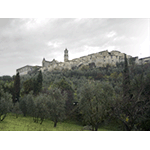Certosa del Galluzzo [Carthusian Monastery of Galluzzo]
The Monastery, on which construction began in 1342 at the initiative of the Florentine banker Niccolò Acciaioli, one of the leading members of the Bankers' Guild, developed over the centuries, acquiring a wealth of important works of art. The Carthusian monks, whose activity in the Certosa came to an end in 1958 when the Cistercians took over the monastery, were intensely involved in conducting research and experimentation, also in the scientific field. Testimony to this activity survives in a sundial with a camera obscura, a double vertical cornerstone clock and two horizontal clocks found inside the Certosa. Particularly interesting are the last two, both placed under the portico in the large cloister. The first of them, with a circular dial, displays the motto "PUDOR SIT UT DILUCULUM", a quotation from the second line, seventh strophe of the Hymn of Saint Ambrose entitled Splendor paternae gloriae, in which the most important moments of the day are mentioned. Dated MDCCCIL (1849), it has hour lines and Roman numerals engraved on it. It has no gnomon. More interesting and unusual is the second, horizontal sundial. Almost quadrangular in shape, but with one side forming the arc of a circle, it has a circular sector with numerous drilled recesses. According to recent studies and experiments, the oblique lines of which it is formed would make it possible to read the hour with the precision of a minute, a concept unique of its kind.
Already in the 16th century, documents mention the activity of the pharmacy, an institution always found in monastic institutions, where remedies for diseases were prepared from medicinal plants. The great "spezieria" had a workshop, a perfume shop, a candle-making shop and warehouses winding underground through the basements of the Certosa. The premises of the pharmacy have remained intact, while its furnishings have been lost. As late as 1934, Pedrazzini recorded objects from the 17th century made at Cafaggiolo and Montelupo. At present the pharmacy, famous in the past for its ophthalmic water and its elixir of alkermes, contains furnishings of recent make. Its activity today consists primarily of producing liqueurs and perfumes.
****************************
Texts by Antonella Gozzoli
English translation by Catherine Frost
Last update 22/apr/2008




